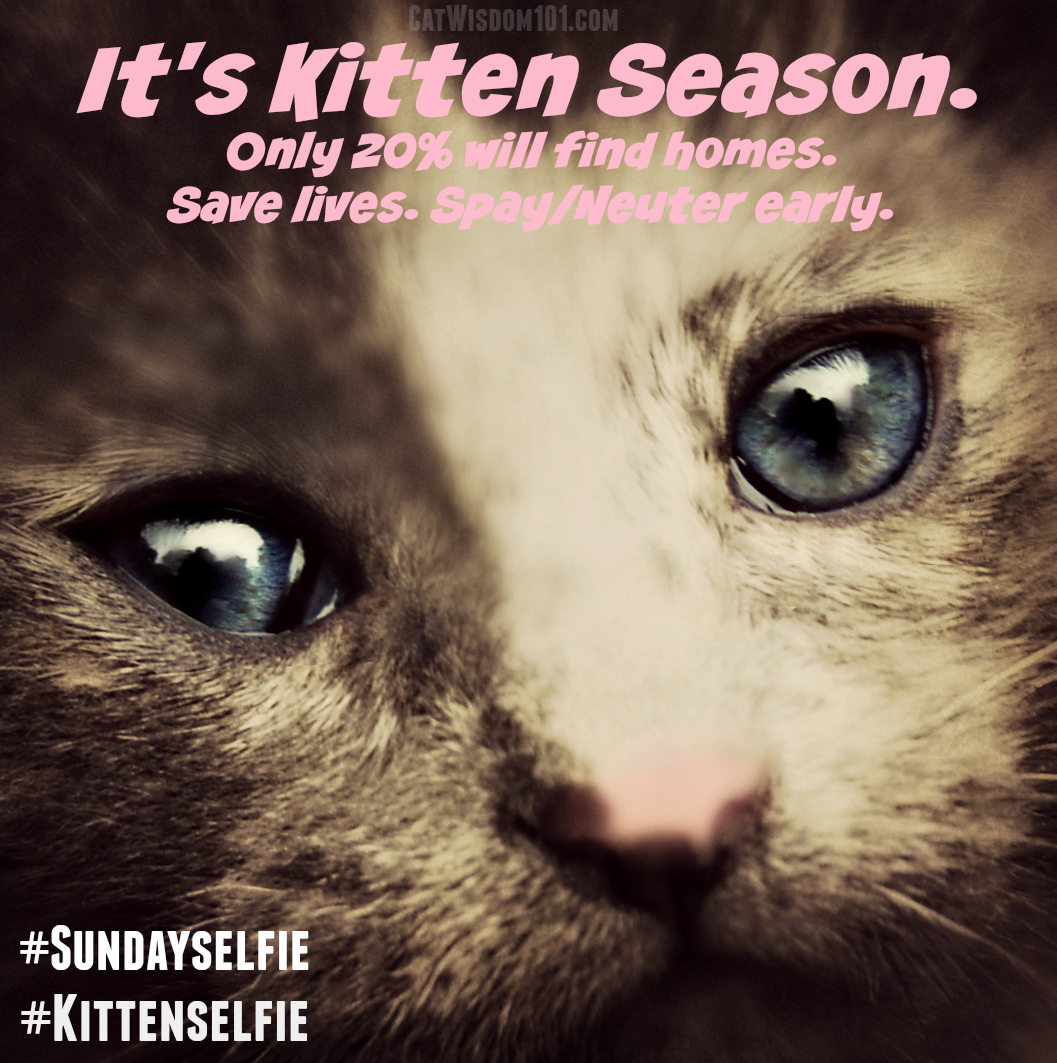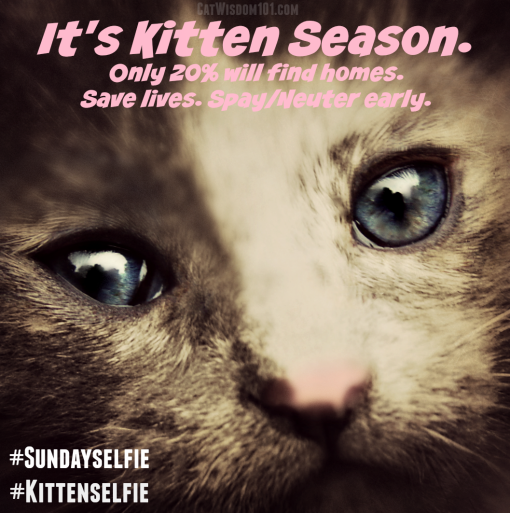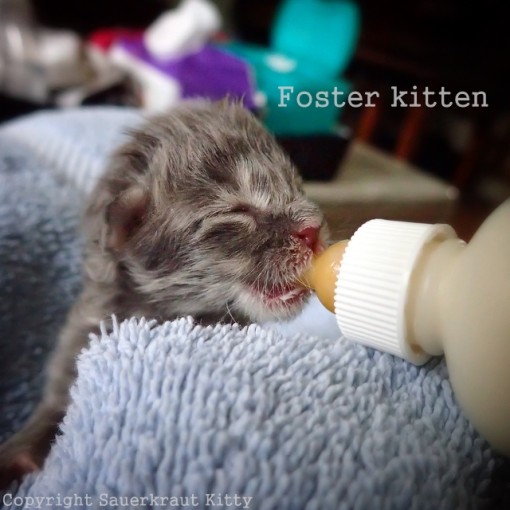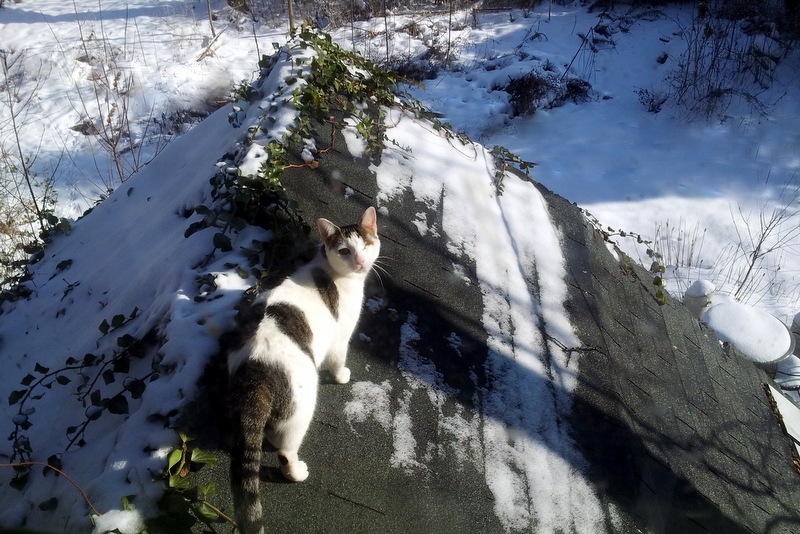
Kitten Season Selfies And Protection Tips
It’s here again; kitten season when more cats are born than will find homes. All their furry cuteness can’t save most of them. Our Sunday Selfies are #Kittenselfies today. Scroll down to the end for #Sundayselfie Blog Hop with There’s A Cat On My Head.

The foster kitten photo is courtesy of Amy Bender who fosters neonatal kittens and will be teaching a kitten fostering course. She also happens to have a famous cat named Sauercraut Kitty, a finalist in the Animal Planet Next CatStar Contest. I can’t wait to meet the whole family in L.A. in June as part of a road trip in an RV from from their home in Oklahoma City. You can be sure I’ll be sharing that adventure!

Our friends at ALLEY CAT ALLIES asked us to share their LIFESAVING SPRING KITTEN PROTECTION TIPS with we do with pleasure. Please share. It will saves lives. Alley Cat Allies is the only national advocacy organization dedicated to the protection and humane treatment of cats. They do awesome work on behalf of all cats including ferals.
Spring marks the beginning of kitten season, when babies are born to community cats who have not yet been trapped, neutered, and returned. Taking home a kitten found outdoors is not necessarily a good idea. Alley Cat Allies offers the following springtime kitten-protection tips:
- Leave kittens with mom. Like all babies, kittens are best left with their mothers who instinctively know how to help their offspring grow up to be strong and healthy cats. Neonatal kittens, 4 weeks old or younger, need constant care and still depend on mom for 100 percent of their food. Kittens 5 to 8 weeks old can begin to eat wet food but are still being weaned. If you know the mother is present, it is best to leave kittens with her. To determine whether the mother is caring for the kittens, wait and observe for two-to- four hours to see if the mother returns. She could just be out looking for food. If she doesn’t return, the kittens could be abandoned. A young kitten living outdoors who does not have a mother present should be taken in and fostered. To determine the age of a kitten, use Alley Cat Allies’ Kitten Progression Chart at www.alleycat.org/KittenProgression.
- Don’t bring neonatal kittens to an animal shelter. Most shelters are not equipped or trained to provide the necessary round-the-clock care for neonatal kittens. If a kitten can’t eat on his own, he will likely be killed at the shelter. Realistically, it’s never a good idea to take a cat to a shelter, no matter the age or level of socialization. More than 70 percent of cats who enter shelters are killed. That number rises to virtually 100 percent for feral cats. Killing is never the answer—it is inhumane and it fails to stabilize or reduce outdoor cat populations.
- Volunteer as a kitten foster parent for a local rescue group. There are kitten foster parent programs associated with rescue groups across the country. Though it is an investment of time and requires training, volunteering to foster young kittens is lifesaving and rewarding.
- Support and practice Trap-Neuter-Return (TNR).TNR is the only effective and humane way of decreasing feral cat populations. In a TNR program, community cats are humanely trapped and brought to a veterinarian to be spayed or neutered, vaccinated, and eartipped (the universal symbol that a cat has been neutered and vaccinated) before being returned to their outdoor homes. Learn more about TNR at www.alleycat.org/TNR.Spaying and neutering community cats prevents new litters, drastically reducing the impact of kitten season. Cats as young as 4 months can have litters, so it is important to spay and neuter kittens as soon as they are ready. A good rule of thumb is the 2 Pound Spay/Neuter Rule—kittens can be safely spayed or neutered at 2 months of age or as soon as they weigh 2 pounds. Learn more about pediatric spay and neuter at www.alleycat.org/spayneuter.
- Advocate for policies and programs that protect cats.Contact your shelter and local officials and tell them you support lifesaving policies for cats, including spay/neuter funding and spay/neuter before adoption. Write letters and call in support of community outreach and education programs that spread awareness about community cats and TNR– you can make a big difference.
Check out http://wwww.alleycat.org/Kittens for a comprehensive guide to caring for kittens.




27 Comments
Pawesome Cats
Great kitten tips – we plan to share them when our kitten season begins 🙂
Savannah's Paw Tracks
Mom L just volunteered at a spay neuter clinic called SNIP yesterday and they had 109 feral cats come through. That means 109 feral cats will no longer add to the kitten season kittens.
meowmeowmans
Great tips. Yes, kitten season is upon us. TNR is so very important if we are ever to have a chance of getting out in front of overpopulation…
Cathy Keisha
Those are great tips. We support TNR in our community
Kitties Blue
This was an excellent post with such good information. Thanks for writing it as your Sunday Selfies post and thanks so much for joining and supporting our blog hop. XOCK, Lily Olivia, Mauricio, Misty May, Giulietta, Fiona, Astrid, Lisbeth and Calista Jo
Sue Brandes
Very good information. I hope all the kitties get wonderful homes.
Connie
I am saddened by the blanket statement that people should avoid shelters. I will admit there are bad ones out there, but there are a lot of shelters that are fully able and willing to provide care for neonates and would probably do a far better job than a person with little to no experience.
You can simply call your local shelter and ask if you do not know how they deal with young kittens.
Flynn
That is important information. The answer to so many unwanted kittens is so easy with spaying, but too many people don’t want to listen and the suffering goes on.
Carolyn
Yes, excellent info! I’ve just joined Cats Protection over here who do great work with neutering and rehoming kitties! Also my local shelter, which isn’t just for cats is having an “event” here locally next week which I am going to try and get to! Spread the word. Will share 🙂
Kjelle Bus aka Charlie Rascal
Impawtent tips and great selfie!
The Swiss Cats
Those are such impawtant informations ! Spay and neuter, neuter and spay, it’s so easy to say, but so hard to put into practice for some people ! Purrs
Tamago
This is such an important information.
We sure love kittens but never want them to end up homeless.
Melissa & Truffles
Precious little angels. Thank you for the great tips.
Annabelle
Excellent and very important information!
Penelope
Most excellent informations!!!
Wes is supporters of TNR!!! Our vet asks if wes will donate $2 extra on every bill to support it (TNR) in our rural area. She also will does low or no cost spay and neuters for those that can’t afford it. Wes does not has a shelter and there is no place for an overabundance of kittens. She advocates for all barn cats and the cats in a couple of local colonies (that keeps the pests down) to bes neutered.
Kisses
Nellie
Caren Gittleman
Fantastic tips and selfies. Tweeted and posted on Cody’s fan page.
Skeeter and Izzy
This is such critical information. It cannot be repaeated enough!!!! Everyone that says anyhing to me about taking an animal to the shelter I tell them the statistics and at our local shelter they are even higher. It is such an easy,simple fix.
We love Ally Cat Allies! They do work everywhere. Right now they have taken two kittens from Texas that were intentionally mutilated one so bad that it had to be euthanized. They are paying for and will continue to pay for medical care for the survivor and they have posted a reward for the quilty person/persons. I think they are truly a fantastic orginization as far as what they do and their scope in areas that they reach.
Go Cats!!!!
Thank you Layla for sharing such fab info.
Luvs
Skeeter and Izzy and the Feral Gang + Twig & Peanut & Romeo >^..^<
Layla Morgan Wilde
Thank-you for all you do for cats. They did a great job outlining the key points of a critically important message.
Kathryn
These kitties are all so adorable. if I had the time and means ( a big house), I’d foster a whole bunch in my house. As it is, living in an apartment, we have our two boyz.
This is just a great idea!
Kathryn
TNR = so important.
Brian Frum
Yep, kitten season is here and it seems to have arrived early.
The Island Cats
Those are great tips. Thanks for sharing. While we love kittens, we don’t like kitten season only because so many don’t find homes.
Deb Barnes - Zee and Zoey
Great information and we do pray one day every kitty will have a furever home and that topics like this are no longer necessary.
Cascadian Nomads Bethany
It is just so easy to spay/neuter- our city has programs that make it FREE!- and there are lots of wonderful TNR organizations and programs too. Someday this homeless kitten madness will end thanks to simple spread the word articles like this. Thank you!
Little Binky and Granny
Very impawtant information. We hope that one day they all will find a forever home and that all the kitties have been TNR, so that this problem gets solved. We do whatever we can to help 🙂 Pawkisses for a Sunny Sunday 🙂 <3
Summer
These are such important things to know, and do! Kitten season sounds cute, but it is really brutal.